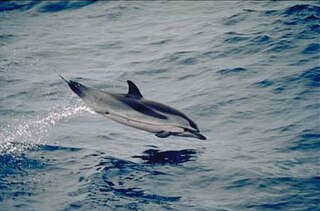Related Research Articles

The Clymene dolphin, in older texts known as the short-snouted spinner dolphin, is a dolphin endemic to the Atlantic Ocean. It is the only confirmed case of hybrid speciation in marine mammals, descending from the spinner dolphin and the striped dolphin.

The striped dolphin is an extensively researched dolphin found in temperate and tropical waters of all the world's oceans. It is a member of the oceanic dolphin family, Delphinidae.

Beauveria is a genus of asexually-reproducing fungi allied with the ascomycete family Cordycipitaceae. Its several species are typically insect pathogens. The sexual states (teleomorphs) of Beauveria species, where known, are species of Cordyceps.

The Microascales are an order of fungi in the class Sordariomycetes, subclass Hypocreomycetidae. This is a relatively small order of mostly saprobic fungi that live in soil, rotting vegetation and dung. Some species are plant pathogens, such as Ceratocystis fimbriata, transmitted by beetles to living trees and causing cacao wilt and many other economically important diseases. Species in the genus Pseudallescheria are pathogenic to humans The order was circumscribed in 1980. Wijayawardene et al. in 2020 added more families and genera to the order.
Amphirosellinia is a genus of five species of fungi in the family Xylariaceae. It was circumscribed in 2004 with A. nigrospora as the type species. The genus name refers to the similarities in morphology it shares with the genus Rosellinia. Amphirosellinia species grow inside the bark of dicot trees, forming stromata encased by black, carbonized perithecia. The ascospores are brown and ellipsoid to cylindrical in shape. The anamorph forms of Amphirosellinia have geniculate (zig-zag) conidiogenous regions.
Stenella canavaliae or Stenella canavaliae-roseae, formerly known as Cercospora canavaliae is a species of anamorphic fungi. It causes the brown leaf mould of Canavalia species.
Stenella sinuosogeniculata is a species of anamorphic fungi.
Stenella stipae is a species of anamorphic fungi.
Stenella tristaniae is a species of anamorphic fungi.
Stenella vangueriae is a species of anamorphic fungi.
Stenella iteae is a species of anamorphic fungi.
Stenella africana is a species of anamorphic fungi.
Stenella gynoxidicola, formerly Cladosporium gynoxidicola is a species of anamorphic fungi.
Stenella capparidicola, formerly Cercospora capparidicola is a species of anamorphic fungi.
Stenella constricta, formerly Cercospora capparidicola is a species of anamorphic fungi.
Stenella uniformis, formerly Cercospora capparidicola is a species of anamorphic fungi.
Stenella vermiculata, formerly Cercospora capparidicola is a species of anamorphic fungi.
Piricaudiopsis rhaphidophorae is a fungus occurring on dead branches of Rhaphidophora decursiva, hence its name. It was first found in a tropical forest in southern China. It differs from other Piricaudiopsis species in conidial morphology and in the proliferation of its conidiogenous cell. The presence or proliferation of the conidiogenous cells and the conidial appendages, as well as the height of its conidia are considered putative phylogenetic characters of this genus.
Piricaudiopsis rosae is a fungus occurring on dead branches of Rosa chinensis, hence its name. It was first found in a tropical forest in southern China. It differs from other Piricaudiopsis species in conidial morphology and in the proliferation of its conidiogenous cell. The presence or proliferation of the conidiogenous cells and the conidial appendages, as well as the height of its conidia are considered putative phylogenetic characters of this genus.
Piricaudiopsis punicae is a fungus occurring on dead branches of Punica granatum, hence its name. It was first found in a tropical forest in southern China. It differs from other Piricaudiopsis species in conidial morphology and in the proliferation of its conidiogenous cell. The presence or proliferation of the conidiogenous cells and the conidial appendages, as well as the height of its conidia are considered putative phylogenetic characters of this genus.
References
- ↑ "Stenella". MycoBank. International Mycological Association. Retrieved 2012-10-31.